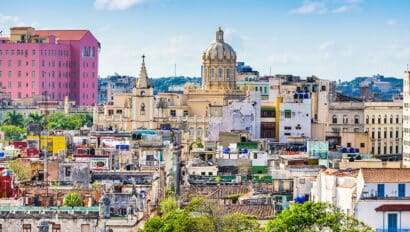Sure, many mountains stand magnificent, but what about peaks formed of rainbow-striped rock?
Likewise, lots of lakes are beautiful, but have you ever seen one filled with frozen bubbles, or bright bubblegum pink?
And as spectacular as a starry night sky might be, how about the heavens with meteors hurtling through or dancing dashes of light?
Mother Nature never ceases to amaze us, but now and again she takes things to a whole new level of weird and wonderful.
Read on for our favorite natural phenomena worldwide, spectacles that even when seen, are hard to believe…
Meteor showers
When space dust passes through the Earth’s atmosphere in the trail of a comet or asteroid, it burns in bright, sometimes colorful streaks. That space dust consists of meteors—lumps of rock or ice in all shapes and sizes—which zipping through the atmosphere, appear as not one shooting star but a shower of them. Meteor showers that can be seen from earth happen around 30 times a year around certain constellations and a spectacular place to see them includes Alaska’s Denali National Park.
Rainbow Mountain in Peru
This is Peru‘s Rainbow Mountain, also known as Vinicunca. Over millions and millions of years, mineral deposits have settled, creating colorful stripes in all directions. This spectacle has only become visible in the last decade due to global warming. Before then, the Andean peak was covered in snow and ice.
Salar de Uyuni in Bolivia
Salar de Uyuni is the world’s biggest salt flat, covering over 4000 square miles. When it floods, a magnificent mirror forms blurring the earth and sky in a world of white and blue.
Firefall in Yosemite
You’ll need a coming together of perfect positioning and conditions to experience the Firefall: in the middle of February, in the Yosemite National Park, looking at the Horsetail Falls, just before sunset with just the right levels of light, rainfall and sky clarity. And if all of the above coincide, you’ll witness the Firefalls, where pouring lava appears to cascade down the cliffside.
Frozen bubbles in Canada
These aren’t alien jellyfish on the surface of Mars—they’re frozen bubbles of methane trapped under the water of Lake Abraham in Alberta, Canada in the Rocky Mountains. They come about as a result of bacteria below the surface, which release gas in bubbles forming these icy white circles. When the water melts in springtime they pop and fizz like hiccups.
Aurora Borealis in Iceland
As charged particles from the sun collide with atoms and molecules in the Earth’s atmosphere, the change in energy releases bursts of colorful light that dance through the night sky. Causing awe and mystery for millennia, they’ve been interpreted as dark omens, good charms, spirits of people and animals and appearances of the Gods. The magical and magnificent display is drawn by the Earth’s magnetic field and northern nations like Iceland are an incredible places to see them.
Rainbow river in Colombia
The Caño Cristales river in Colombia’s Sierra de la Macarena National Park has a technicolor transformation every summer: bright blue water, yellow sand, brown rocks and green algae are joined by a rich red riverbed, when the aquatic Macarenia clavigera plant bursts into bloom. The whole thing forms a riveting liquid rainbow, which with waterfalls, rock pools and lush surrounding forest looks like a fairy-tale landscape.
Moonbow in Yosemite
The moonbow or lunar rainbow occurs when moonlight, rather than sunlight is reflected, refracted and dispersed in the droplets of cascading water. On a clear starry night when there’s a full moon, this surreal sight can be seen at Yosemite’s upper and lower falls.
Total solar eclipse
A total solar eclipse takes place on rare occasions when the moon and Earth’s orbits coincide, perfectly positioning the moon in a direct line between the Earth and the sun. The sun forms a glowing ring around the moon and a shadow is cast over the surface of the Earth. It can only be seen from the small part of our planet that falls in the center of that shadow. And it just happens that the next total solar eclipse, on December 14 2020, the path of totality passes over one of the most spectacular places on earth, Chile, with its great lakes, volcanic peaks. We’ve created our Chile Total Solar Eclipse tour especially for this! Join us!
Glowworm Caves in New Zealand
In New Zealand‘s Waitomo region, the Glow worm Grotto has wowed visitors since the 1800’s. Millions of miniscule worms light up the walls and ceilings like stars in the night sky, their silk trailing down in luminous strings.
Wisteria Tunnel in Japan
Over twenty types of wisteria—in all shades of white, purple and pink—trail through this tunnel in the city of Kitakyushu, Japan. It forms one of the most magical walks known to man.
Penitentes in the Andes
Up, up and away in the Andean Mountains between Chile and Argentina, cold temperatures together with high winds create snow fields filled with long, thin spikes called Penitentes.
Luminous beaches in Thailand
Nighttime on certain Thai beaches can resemble a scene from a sci-fi film: schools of bioluminescent fish create an ethereal green-blue neon and if you put your hand into the sea, the glow gets stronger.
Pink Lake in Australia
In Western Australia, Lake Hillier glows a sensational strawberry-gelato pink. The cause is a hot topic, but most believe it to be a certain type of algae that grows in the water which creates the beta-carotene that gives the lake its bubblegum tinge. The birds-eye view, including the lush surrounding forest and the bright blue of the ocean, is a true sight to behold.




